Analyzing Business Communication Strategies at Marks & Spencer
VerifiedAdded on 2023/01/06
|6
|1396
|70
Report
AI Summary
This report analyzes the business communication practices of Marks & Spencer, a British retailer. It explores how the organization utilizes different types of business information, including verbal, on-screen, and written communication, to fulfill its objectives. The report details various types of corporate communication, such as internal communication through employee handbooks and external communication via social media and websites. Furthermore, it discusses legal and ethical issues like the Freedom of Information Act and the ethical use of email, alongside the methods used for both electronic and non-electronic communication. The conclusion highlights the importance of effective business communication in maximizing productivity and minimizing disputes within an organization.
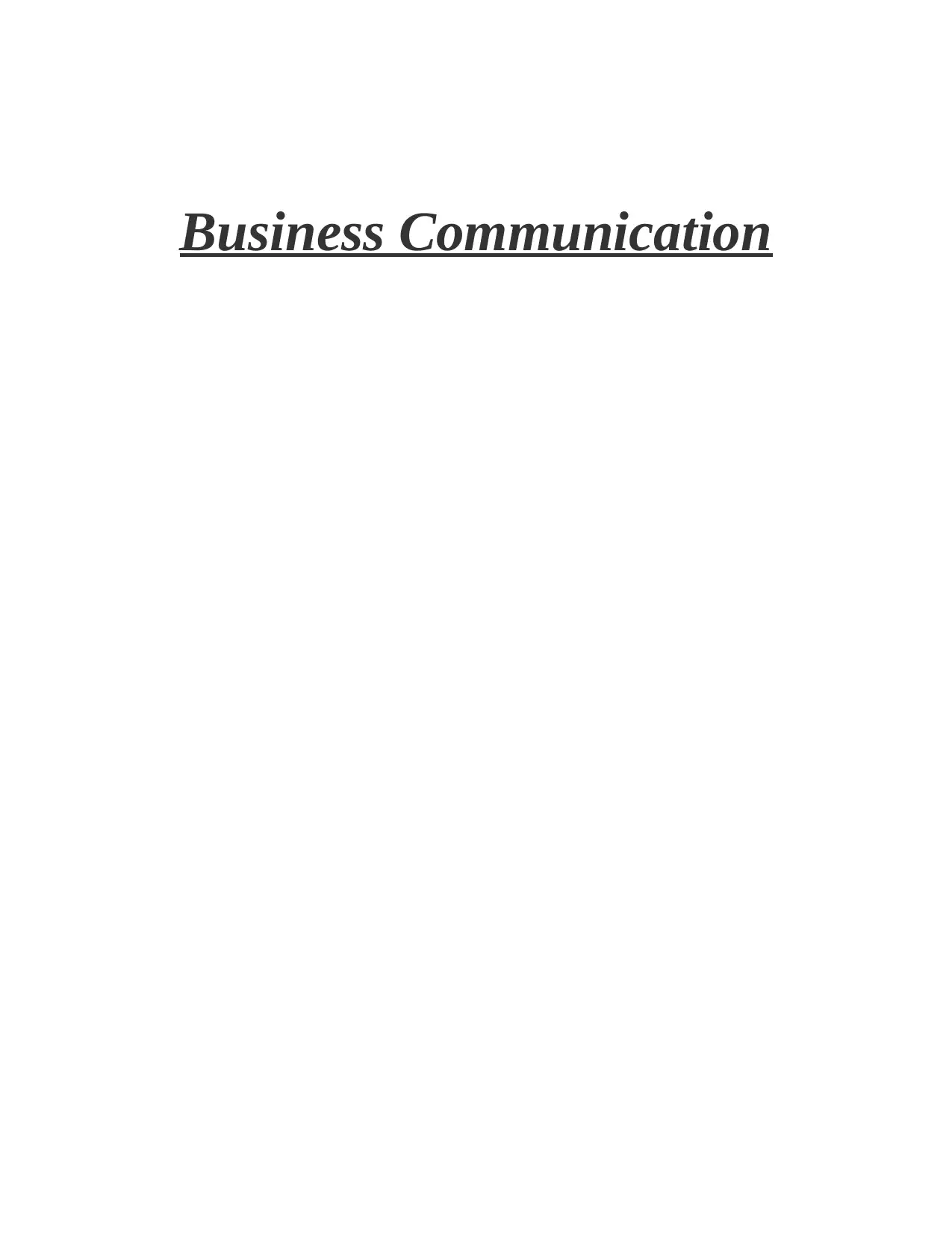
Business Communication
Paraphrase This Document
Need a fresh take? Get an instant paraphrase of this document with our AI Paraphraser
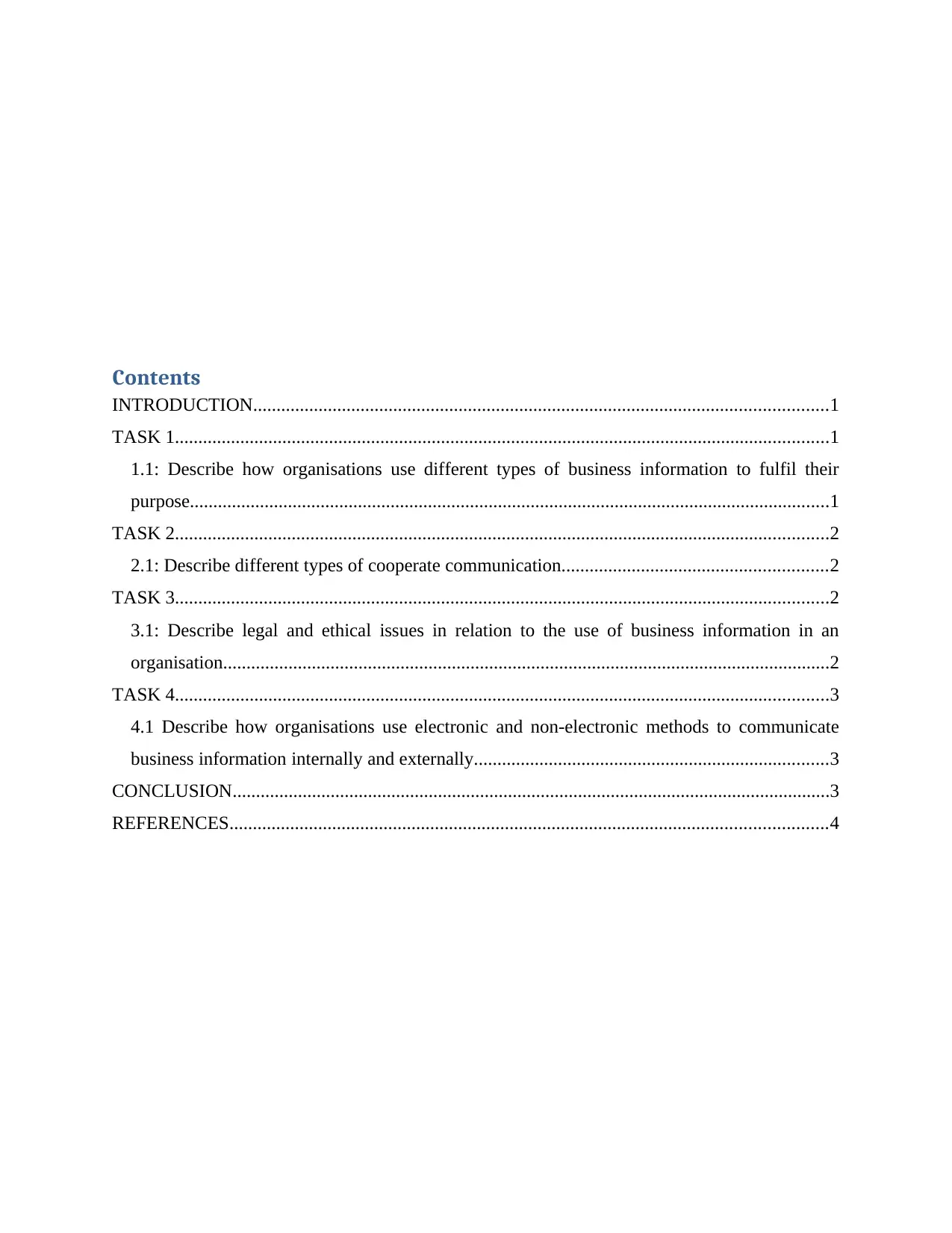
Contents
INTRODUCTION...........................................................................................................................1
TASK 1............................................................................................................................................1
1.1: Describe how organisations use different types of business information to fulfil their
purpose.........................................................................................................................................1
TASK 2............................................................................................................................................2
2.1: Describe different types of cooperate communication.........................................................2
TASK 3............................................................................................................................................2
3.1: Describe legal and ethical issues in relation to the use of business information in an
organisation..................................................................................................................................2
TASK 4............................................................................................................................................3
4.1 Describe how organisations use electronic and non-electronic methods to communicate
business information internally and externally............................................................................3
CONCLUSION................................................................................................................................3
REFERENCES................................................................................................................................4
INTRODUCTION...........................................................................................................................1
TASK 1............................................................................................................................................1
1.1: Describe how organisations use different types of business information to fulfil their
purpose.........................................................................................................................................1
TASK 2............................................................................................................................................2
2.1: Describe different types of cooperate communication.........................................................2
TASK 3............................................................................................................................................2
3.1: Describe legal and ethical issues in relation to the use of business information in an
organisation..................................................................................................................................2
TASK 4............................................................................................................................................3
4.1 Describe how organisations use electronic and non-electronic methods to communicate
business information internally and externally............................................................................3
CONCLUSION................................................................................................................................3
REFERENCES................................................................................................................................4
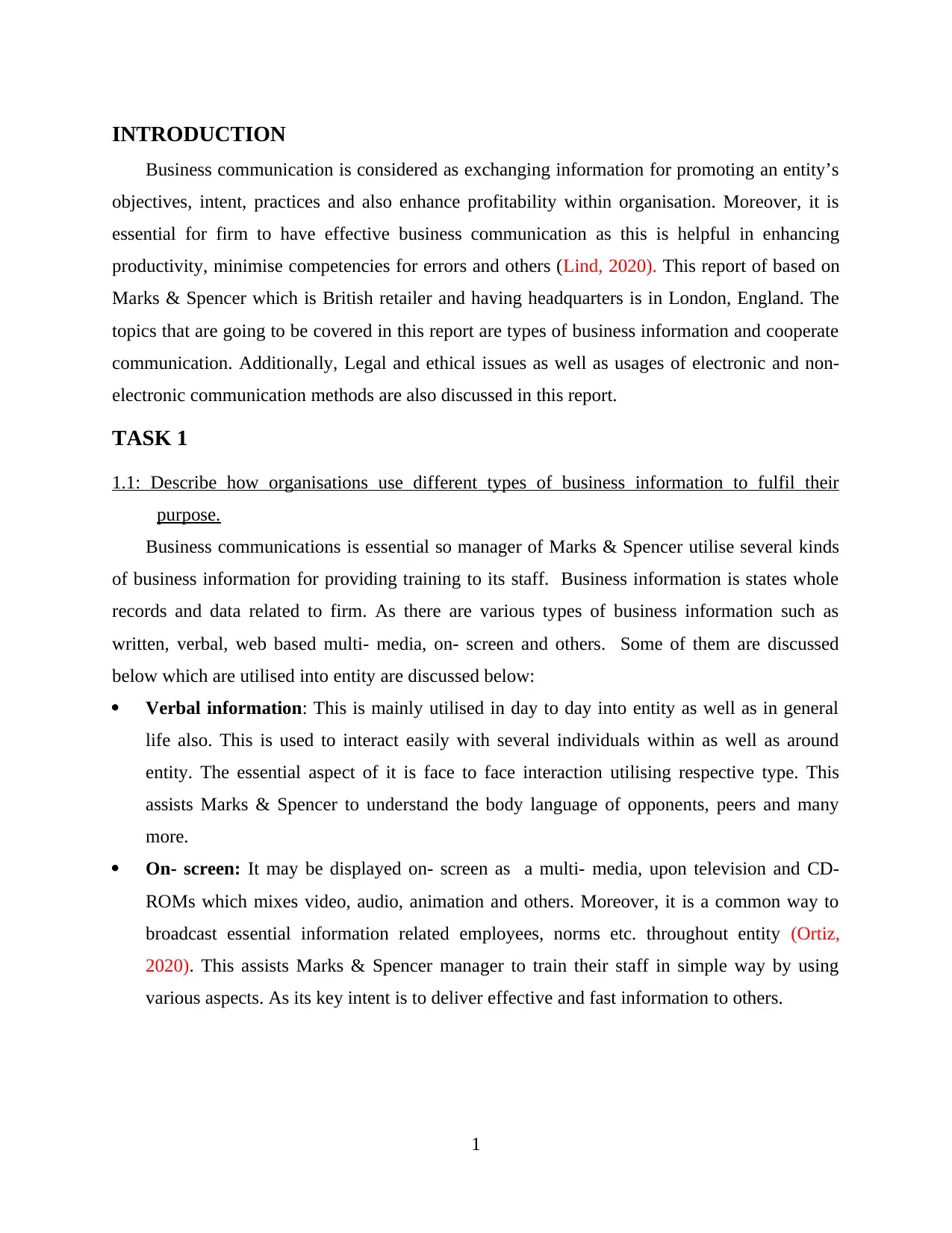
INTRODUCTION
Business communication is considered as exchanging information for promoting an entity’s
objectives, intent, practices and also enhance profitability within organisation. Moreover, it is
essential for firm to have effective business communication as this is helpful in enhancing
productivity, minimise competencies for errors and others (Lind, 2020). This report of based on
Marks & Spencer which is British retailer and having headquarters is in London, England. The
topics that are going to be covered in this report are types of business information and cooperate
communication. Additionally, Legal and ethical issues as well as usages of electronic and non-
electronic communication methods are also discussed in this report.
TASK 1
1.1: Describe how organisations use different types of business information to fulfil their
purpose.
Business communications is essential so manager of Marks & Spencer utilise several kinds
of business information for providing training to its staff. Business information is states whole
records and data related to firm. As there are various types of business information such as
written, verbal, web based multi- media, on- screen and others. Some of them are discussed
below which are utilised into entity are discussed below:
Verbal information: This is mainly utilised in day to day into entity as well as in general
life also. This is used to interact easily with several individuals within as well as around
entity. The essential aspect of it is face to face interaction utilising respective type. This
assists Marks & Spencer to understand the body language of opponents, peers and many
more.
On- screen: It may be displayed on- screen as a multi- media, upon television and CD-
ROMs which mixes video, audio, animation and others. Moreover, it is a common way to
broadcast essential information related employees, norms etc. throughout entity (Ortiz,
2020). This assists Marks & Spencer manager to train their staff in simple way by using
various aspects. As its key intent is to deliver effective and fast information to others.
1
Business communication is considered as exchanging information for promoting an entity’s
objectives, intent, practices and also enhance profitability within organisation. Moreover, it is
essential for firm to have effective business communication as this is helpful in enhancing
productivity, minimise competencies for errors and others (Lind, 2020). This report of based on
Marks & Spencer which is British retailer and having headquarters is in London, England. The
topics that are going to be covered in this report are types of business information and cooperate
communication. Additionally, Legal and ethical issues as well as usages of electronic and non-
electronic communication methods are also discussed in this report.
TASK 1
1.1: Describe how organisations use different types of business information to fulfil their
purpose.
Business communications is essential so manager of Marks & Spencer utilise several kinds
of business information for providing training to its staff. Business information is states whole
records and data related to firm. As there are various types of business information such as
written, verbal, web based multi- media, on- screen and others. Some of them are discussed
below which are utilised into entity are discussed below:
Verbal information: This is mainly utilised in day to day into entity as well as in general
life also. This is used to interact easily with several individuals within as well as around
entity. The essential aspect of it is face to face interaction utilising respective type. This
assists Marks & Spencer to understand the body language of opponents, peers and many
more.
On- screen: It may be displayed on- screen as a multi- media, upon television and CD-
ROMs which mixes video, audio, animation and others. Moreover, it is a common way to
broadcast essential information related employees, norms etc. throughout entity (Ortiz,
2020). This assists Marks & Spencer manager to train their staff in simple way by using
various aspects. As its key intent is to deliver effective and fast information to others.
1
⊘ This is a preview!⊘
Do you want full access?
Subscribe today to unlock all pages.

Trusted by 1+ million students worldwide
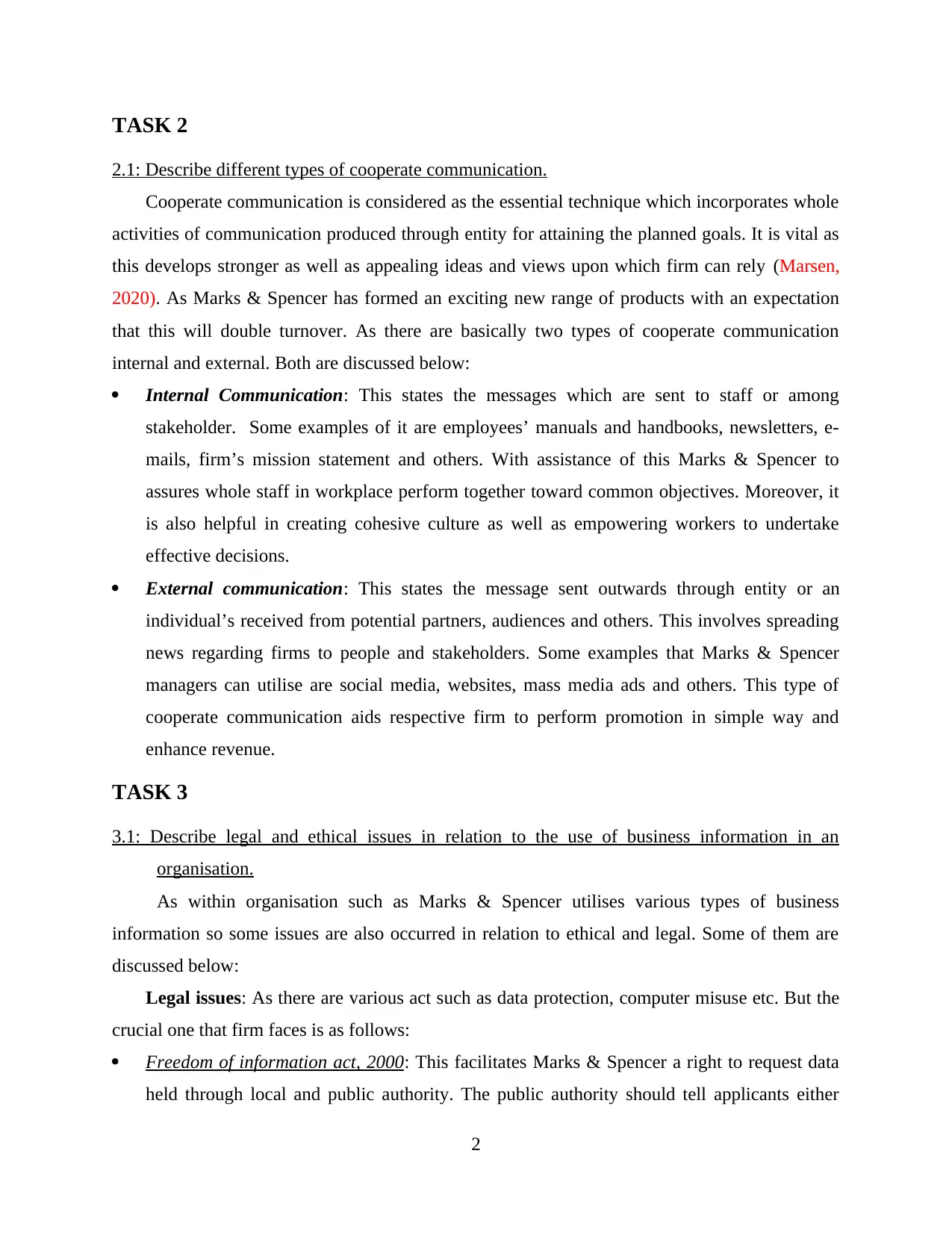
TASK 2
2.1: Describe different types of cooperate communication.
Cooperate communication is considered as the essential technique which incorporates whole
activities of communication produced through entity for attaining the planned goals. It is vital as
this develops stronger as well as appealing ideas and views upon which firm can rely (Marsen,
2020). As Marks & Spencer has formed an exciting new range of products with an expectation
that this will double turnover. As there are basically two types of cooperate communication
internal and external. Both are discussed below:
Internal Communication: This states the messages which are sent to staff or among
stakeholder. Some examples of it are employees’ manuals and handbooks, newsletters, e-
mails, firm’s mission statement and others. With assistance of this Marks & Spencer to
assures whole staff in workplace perform together toward common objectives. Moreover, it
is also helpful in creating cohesive culture as well as empowering workers to undertake
effective decisions.
External communication: This states the message sent outwards through entity or an
individual’s received from potential partners, audiences and others. This involves spreading
news regarding firms to people and stakeholders. Some examples that Marks & Spencer
managers can utilise are social media, websites, mass media ads and others. This type of
cooperate communication aids respective firm to perform promotion in simple way and
enhance revenue.
TASK 3
3.1: Describe legal and ethical issues in relation to the use of business information in an
organisation.
As within organisation such as Marks & Spencer utilises various types of business
information so some issues are also occurred in relation to ethical and legal. Some of them are
discussed below:
Legal issues: As there are various act such as data protection, computer misuse etc. But the
crucial one that firm faces is as follows:
Freedom of information act, 2000: This facilitates Marks & Spencer a right to request data
held through local and public authority. The public authority should tell applicants either
2
2.1: Describe different types of cooperate communication.
Cooperate communication is considered as the essential technique which incorporates whole
activities of communication produced through entity for attaining the planned goals. It is vital as
this develops stronger as well as appealing ideas and views upon which firm can rely (Marsen,
2020). As Marks & Spencer has formed an exciting new range of products with an expectation
that this will double turnover. As there are basically two types of cooperate communication
internal and external. Both are discussed below:
Internal Communication: This states the messages which are sent to staff or among
stakeholder. Some examples of it are employees’ manuals and handbooks, newsletters, e-
mails, firm’s mission statement and others. With assistance of this Marks & Spencer to
assures whole staff in workplace perform together toward common objectives. Moreover, it
is also helpful in creating cohesive culture as well as empowering workers to undertake
effective decisions.
External communication: This states the message sent outwards through entity or an
individual’s received from potential partners, audiences and others. This involves spreading
news regarding firms to people and stakeholders. Some examples that Marks & Spencer
managers can utilise are social media, websites, mass media ads and others. This type of
cooperate communication aids respective firm to perform promotion in simple way and
enhance revenue.
TASK 3
3.1: Describe legal and ethical issues in relation to the use of business information in an
organisation.
As within organisation such as Marks & Spencer utilises various types of business
information so some issues are also occurred in relation to ethical and legal. Some of them are
discussed below:
Legal issues: As there are various act such as data protection, computer misuse etc. But the
crucial one that firm faces is as follows:
Freedom of information act, 2000: This facilitates Marks & Spencer a right to request data
held through local and public authority. The public authority should tell applicants either
2
Paraphrase This Document
Need a fresh take? Get an instant paraphrase of this document with our AI Paraphraser
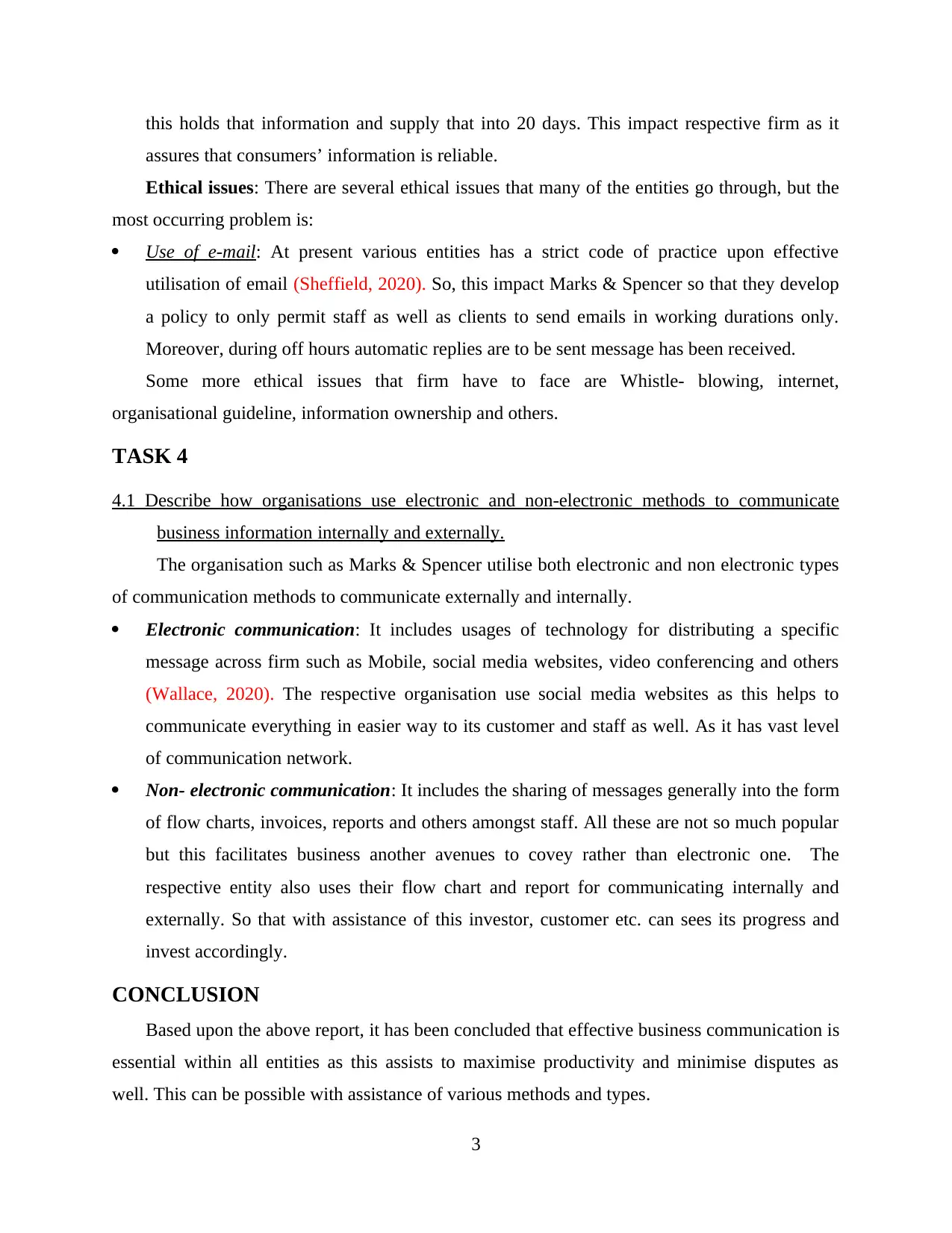
this holds that information and supply that into 20 days. This impact respective firm as it
assures that consumers’ information is reliable.
Ethical issues: There are several ethical issues that many of the entities go through, but the
most occurring problem is:
Use of e-mail: At present various entities has a strict code of practice upon effective
utilisation of email (Sheffield, 2020). So, this impact Marks & Spencer so that they develop
a policy to only permit staff as well as clients to send emails in working durations only.
Moreover, during off hours automatic replies are to be sent message has been received.
Some more ethical issues that firm have to face are Whistle- blowing, internet,
organisational guideline, information ownership and others.
TASK 4
4.1 Describe how organisations use electronic and non-electronic methods to communicate
business information internally and externally.
The organisation such as Marks & Spencer utilise both electronic and non electronic types
of communication methods to communicate externally and internally.
Electronic communication: It includes usages of technology for distributing a specific
message across firm such as Mobile, social media websites, video conferencing and others
(Wallace, 2020). The respective organisation use social media websites as this helps to
communicate everything in easier way to its customer and staff as well. As it has vast level
of communication network.
Non- electronic communication: It includes the sharing of messages generally into the form
of flow charts, invoices, reports and others amongst staff. All these are not so much popular
but this facilitates business another avenues to covey rather than electronic one. The
respective entity also uses their flow chart and report for communicating internally and
externally. So that with assistance of this investor, customer etc. can sees its progress and
invest accordingly.
CONCLUSION
Based upon the above report, it has been concluded that effective business communication is
essential within all entities as this assists to maximise productivity and minimise disputes as
well. This can be possible with assistance of various methods and types.
3
assures that consumers’ information is reliable.
Ethical issues: There are several ethical issues that many of the entities go through, but the
most occurring problem is:
Use of e-mail: At present various entities has a strict code of practice upon effective
utilisation of email (Sheffield, 2020). So, this impact Marks & Spencer so that they develop
a policy to only permit staff as well as clients to send emails in working durations only.
Moreover, during off hours automatic replies are to be sent message has been received.
Some more ethical issues that firm have to face are Whistle- blowing, internet,
organisational guideline, information ownership and others.
TASK 4
4.1 Describe how organisations use electronic and non-electronic methods to communicate
business information internally and externally.
The organisation such as Marks & Spencer utilise both electronic and non electronic types
of communication methods to communicate externally and internally.
Electronic communication: It includes usages of technology for distributing a specific
message across firm such as Mobile, social media websites, video conferencing and others
(Wallace, 2020). The respective organisation use social media websites as this helps to
communicate everything in easier way to its customer and staff as well. As it has vast level
of communication network.
Non- electronic communication: It includes the sharing of messages generally into the form
of flow charts, invoices, reports and others amongst staff. All these are not so much popular
but this facilitates business another avenues to covey rather than electronic one. The
respective entity also uses their flow chart and report for communicating internally and
externally. So that with assistance of this investor, customer etc. can sees its progress and
invest accordingly.
CONCLUSION
Based upon the above report, it has been concluded that effective business communication is
essential within all entities as this assists to maximise productivity and minimise disputes as
well. This can be possible with assistance of various methods and types.
3
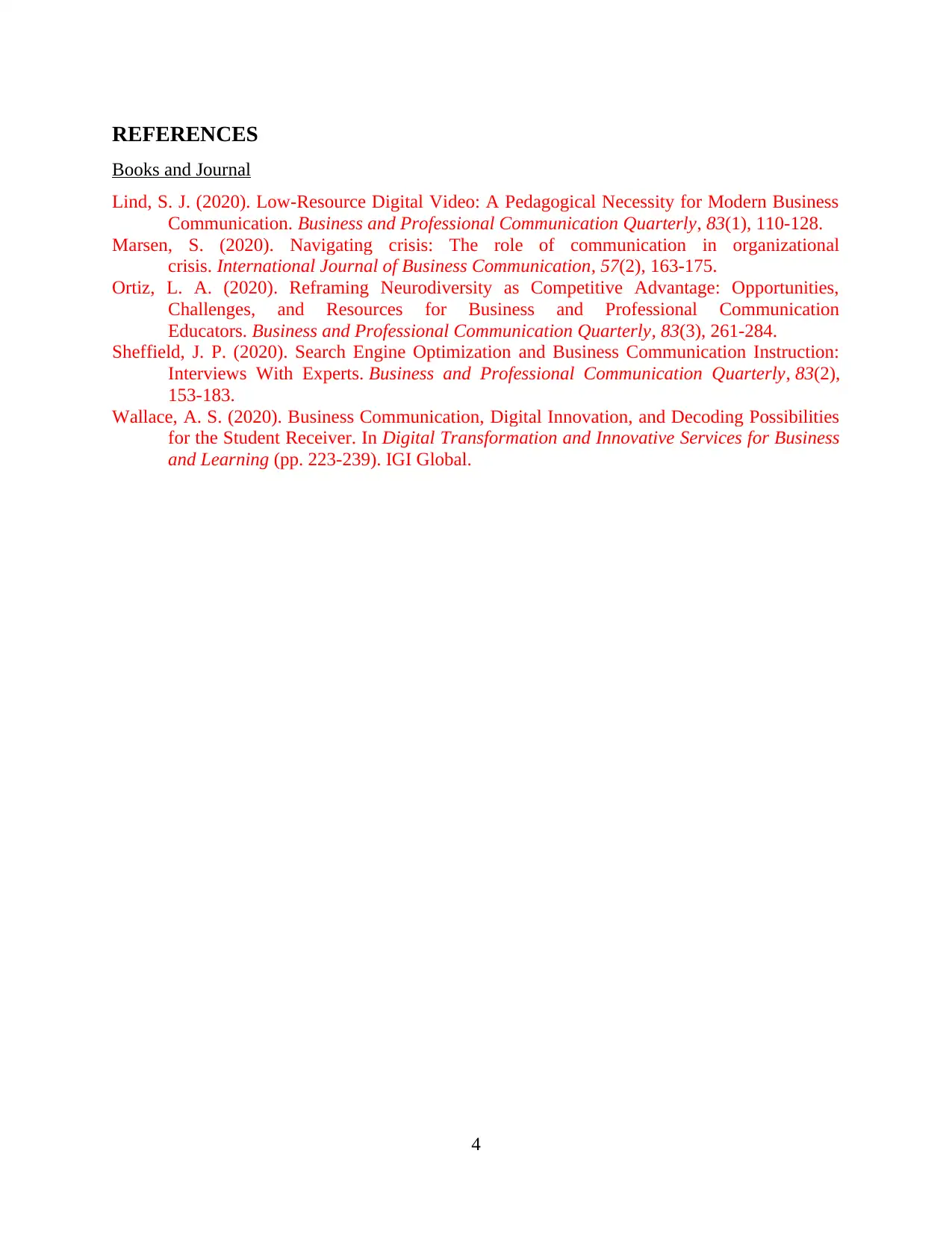
REFERENCES
Books and Journal
Lind, S. J. (2020). Low-Resource Digital Video: A Pedagogical Necessity for Modern Business
Communication. Business and Professional Communication Quarterly, 83(1), 110-128.
Marsen, S. (2020). Navigating crisis: The role of communication in organizational
crisis. International Journal of Business Communication, 57(2), 163-175.
Ortiz, L. A. (2020). Reframing Neurodiversity as Competitive Advantage: Opportunities,
Challenges, and Resources for Business and Professional Communication
Educators. Business and Professional Communication Quarterly, 83(3), 261-284.
Sheffield, J. P. (2020). Search Engine Optimization and Business Communication Instruction:
Interviews With Experts. Business and Professional Communication Quarterly, 83(2),
153-183.
Wallace, A. S. (2020). Business Communication, Digital Innovation, and Decoding Possibilities
for the Student Receiver. In Digital Transformation and Innovative Services for Business
and Learning (pp. 223-239). IGI Global.
4
Books and Journal
Lind, S. J. (2020). Low-Resource Digital Video: A Pedagogical Necessity for Modern Business
Communication. Business and Professional Communication Quarterly, 83(1), 110-128.
Marsen, S. (2020). Navigating crisis: The role of communication in organizational
crisis. International Journal of Business Communication, 57(2), 163-175.
Ortiz, L. A. (2020). Reframing Neurodiversity as Competitive Advantage: Opportunities,
Challenges, and Resources for Business and Professional Communication
Educators. Business and Professional Communication Quarterly, 83(3), 261-284.
Sheffield, J. P. (2020). Search Engine Optimization and Business Communication Instruction:
Interviews With Experts. Business and Professional Communication Quarterly, 83(2),
153-183.
Wallace, A. S. (2020). Business Communication, Digital Innovation, and Decoding Possibilities
for the Student Receiver. In Digital Transformation and Innovative Services for Business
and Learning (pp. 223-239). IGI Global.
4
⊘ This is a preview!⊘
Do you want full access?
Subscribe today to unlock all pages.

Trusted by 1+ million students worldwide
1 out of 6
Related Documents
Your All-in-One AI-Powered Toolkit for Academic Success.
+13062052269
info@desklib.com
Available 24*7 on WhatsApp / Email
![[object Object]](/_next/static/media/star-bottom.7253800d.svg)
Unlock your academic potential
Copyright © 2020–2025 A2Z Services. All Rights Reserved. Developed and managed by ZUCOL.





